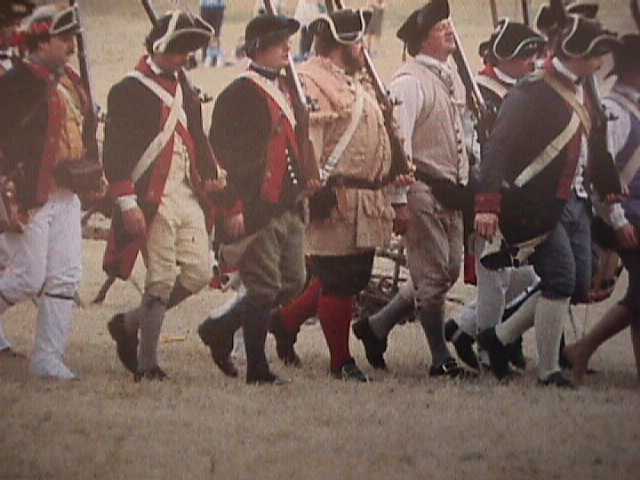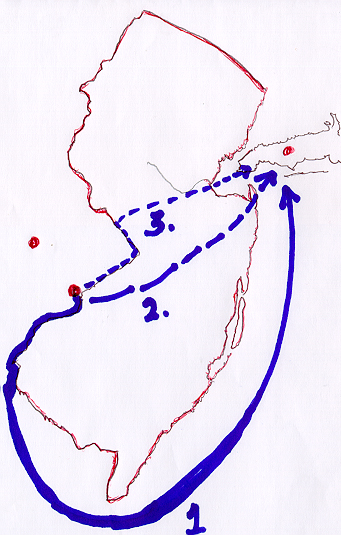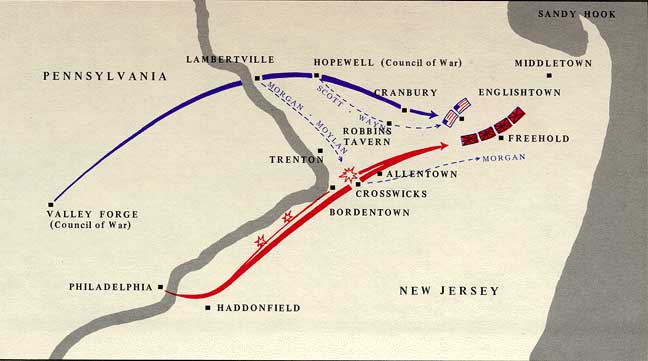New Jersey played a major role in the American Revolution and the Battle of Monmouth is often said to be a critical turning point in the Colonists' fight for freedom. Before reading about the key players in the battle trace the path that the British and Americans took in reaching this historic site.

The British strategy of evacuating Philadelphia to New York took place on June 18,1778. This picture was taken from a reenactment at the Battle of Monmouth. Selected picture by John Blair.
Source: Abraham Resnick, A Panorama of New Jersey.Walsworth, 1991, p. 104.
Map Activity
After reading the facts that determined the rationale for General Henry Clinton's evacuation of Philadelphia in the Spring of 1778, try to determine which route Clinton would take in his march to New York City.
Facts
- General Clinton commanded nearly seventeen thousand men in Philadelphia. They were made up of British and Hessian regulars in the Army and several battalions of Loyalists.
- General George Washington, Commander of the Continental Army, was still in his winter encampment by late Spring of 1778. He had nearly as many men as General Clinton. During the previous winter, General Friedrich Von Stueben drilled the soldiers into a respectable army that was now capable of facing the Redcoats on their own terms.
- The British wanted to avoid a clash with the French Navy along the Delaware River. The French had become allies of the colonists.
- Clinton needed to transport a large volume of supplies in a baggage train (supply wagons) that would stretch over twelve miles. This was a slow process that would take several weeks. (Major Andre's Journal, New York: Arno Press, 1968, p.75)
- General Horatio Gates was marching south from New York to meet with Washington's army. The fear of a rebel attack along the Raritan River put General Clinton's wagon train at risk.
- The British Army could do more good in New York City and then link up with the Royal Navy and attack colonial ports on the east coast before the French could provide assistance to the colonists.
Main Battle: This section describes the actual events that led up to the battle and the main characters that were involved. Activities will involve asking you to make up alternative strategies that will alter the actual events that took place. One example might be, placing General Washington on the battlefield before General Lee arrives. See if your strategies could have made a difference in the final outcome. In completing this activity you may draw maps, correspond with letters or change the actual event that took place.
Lee's Letters: This part contains the letters written by Lee to Washington and the subsequent reaction taken by Washington that led to Lee's court-martial. The activities in this section will ask you to analyze the letters and justify Lee's and Washington's actions.You may do this by analyzing each of the documents or writing a general essay detailing specific changes.
Court-Martial: The last section follows the proceedings of the Court-Martial. After analyzing the documents presented you will be asked to judge Lee's Actions.
Map of alternative routes through New Jersey

Actual Route Taken by Clinton

Reasons Clinton chose the route toward Sandy Hook
- Safer route with less opportunity for enemy attack.
- Washington would have to meet in open combat.
- No large rivers such as the Raritan to impede their safety.
- It was believed that General Gates was headed toward New Jersey from upstate New York.
- They would receive adequate support from the port of New York.